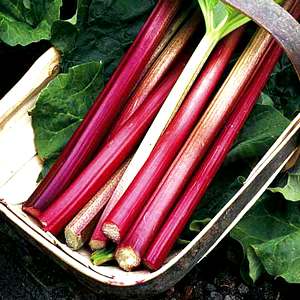
Learning Download: How to Grow Rhubarb
From Seed to Harvest: A guide to growing rhubarb.
The rhubarb plant is a beautifully colored and tart stem that often makes delicious pies or jams. It is a cool season plant and grows as a perennial, meaning it comes back every year. It is drought resistant, and sometimes it is grown for its foliage to be used as a border. Rhubarb is actually considered to be a vegetable, though many think that it is a fruit.
To plant:
Plant rhubarb crowns that are 1 year old in the spring as soon as the ground can be worked when the roots are still dormant and no new growth has begun. You can also plant rhubarb in the fall once dormancy sets in. When planting, space the plants 3-4' feet apart with the roots 1 or 2 inches below the soil line. Prior to planting, amend the soil with compost and manure to aid in growth.
To grow:
Rhubarb grows best in well-drained, fertile soil and in full sun. Mulch the plants heavily with straw or manure to deter weeds, retain moisture and continue to provide nutrients to the soil. Split the rhubarb plants every three to four years, as this will help continue good growth. Divide the plants when they are dormant in the spring. Rhubarb plants require plenty of water. If you don’t think you are watering the plants enough, dig into the soil nearby the plants. Soil should be moist up to 4 inches deep. If it is soggy, refrain from watering for a few days until it dries out.
To harvest:
Rhubarb plants aren’t ready to harvest until their second season of growth, because this is when they have become established. Stalks are ready to harvest when they are 12 to 18 inches in length. The harvest period will run up to 10 weeks once the plants are 3 years old. To harvest, grab the stalk at its base and pull and twist it away from the ground. You can also cut the stalk at the base. Discard the leaves after harvesting. If stalks are too slender do not harvest them.
What rhubarb craves:
Rhubarb plants are heavy feeders. Apply a 25-3-3 or 10-6-4 high nitrogen fertilizer when the ground thaws in the spring. This is a good time to fertilize because the fertilizer will go into the ground but won’t harm the roots. If using a granular fertilizer, apply one-and-a-half pounds per 100 square feet of rhubarb plants. If you prefer to grow organically, mix compost and manure into the soil instead of a chemical fertilizer.
Where to buy rhubarb plants:
You can fine rhubarb seeds and crowns at Urban Farmer.

